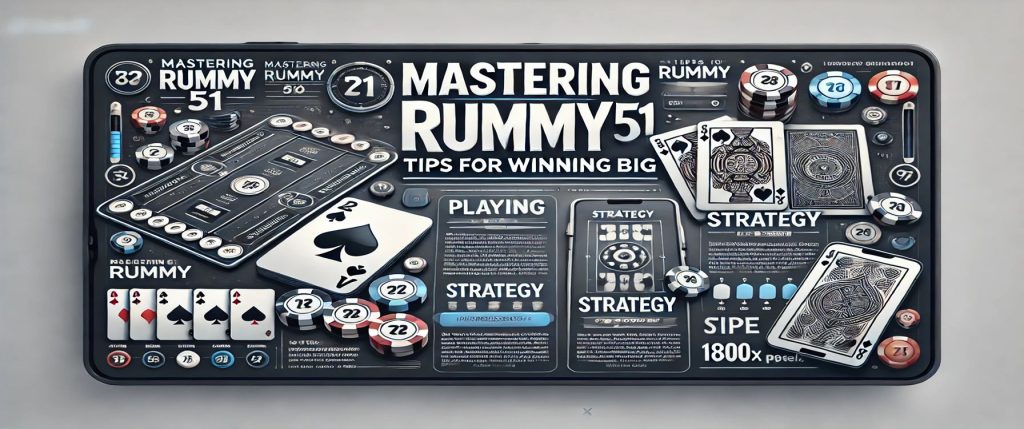
Learning Rummy 51: A Complete Guide Rummy 51 is an engaging card game that blends skill, strategy, & a little bit of luck. A standard deck of cards is used for play, and two to six players are usually involved. Forming legitimate sets and runs is the goal, with the ultimate goal being to “go out” by melding all of your cards before your opponents do. Any player who wants to get better at Rummy 51 must grasp the fundamentals of the game. Each player starts the game with a predetermined number of cards, with the remaining cards forming a draw pile.
Each player draws from the draw pile or the discard pile, and then they each discard one card. The requirement to form melds, which can be either runs (three or more consecutive cards of the same suit) or sets (three or four cards of the same rank), adds a unique twist to the game. Rummy 51 has fairly simple rules, but a deeper comprehension of the game’s mechanics is necessary to master it.
Players have to pay attention to the cards that their opponents are discarding in addition to their own hands. A dynamic environment where strategic thinking and adaptability are crucial is produced by this dual focus. Players have to take into account the possibility that their opponents will do the same when they meld their cards. The game is a cerebral experience since it pushes players to consider multiple moves ahead of time.
Players can create winning strategies by practicing and having a firm understanding of the principles. In Rummy 51, the tone of the game can be established by a strong opening hand. It’s critical to assess your cards’ potential for meld formation when you first receive them. Seek out valuable cards that are simple to combine into runs or sets.
If you have several cards of the same rank, for example, you might be close to forming a set. On the other hand, you might be able to form a run if you have multiple cards in the same suit in a row. The secret is figuring out which cards will help your strategy the most & ranking them appropriately.
Evaluating your opponents’ hand is just as crucial as evaluating your own. You might want to keep those cards longer than usual if you see that a player is throwing away cards that could help you finish a run or set. It might be time to discard cards early on, on the other hand, if you have any that are unlikely to form melds. Identifying your hand’s advantages and predicting your opponents’ moves are both important components of creating an opening hand strategy. You can put yourself in a favorable position as the game goes on by doing this.
Being aware of the Discard Pile. In Rummy 51, the discard pile is an important component that has a big influence on how you play. There are opportunities for strategic plays when a player discards a card, making it available for other players to pick up. Pay close attention to the cards your opponents are discarding and the ones they appear to be collecting in order to make efficient use of the discard pile. examining the tactics of the opposition.
You can use this information to help you decide which cards to draw or discard if you observe a player routinely discarding particular suits or ranks. This knowledge can be very helpful in determining your next course of action & maintaining an advantage over your rivals. Drawing strategically.
Careful thought must go into selecting cards from the draw pile. Even though it could be tempting to draw at random in the hopes of drawing a useful card, it’s usually more strategic to evaluate the current situation first. Instead of adding random cards to your hand, concentrate on drawing cards that will help you complete the melds you’re trying to form if you know exactly what they are. Managing Your Draws.
You can maintain control over your hand while monitoring the moves of your opponents by distributing your draws between the draw pile & the discard pile. This can make your strategy more effective. By doing this, you can maintain your flexibility and take advantage of all the chances that are given to you throughout the game.
The ability to spot and exploit your opponents’ patterns is one of the most important Rummy 51 skills. Players frequently disclose their tactics through their selections as they alternately draw and discard cards. For instance, an opponent may be aiming for a particular meld if they routinely remove cards from the discard pile that are related in rank or suit. By keeping an eye out for these trends, you can modify your own approach appropriately, either by preventing them from finishing their melds or by predicting their subsequent moves. Also, knowing the patterns of your opponents can help you decide when to play defensively or aggressively. Hold onto cards that might help your opponent finish their melds if you see that they are about to go out.
This is a more cautious approach to play. On the other hand, if your opponent appears to be having trouble with their hand, you may want to take chances and try to win more quickly. You can obtain a big edge in Rummy 51 by constantly monitoring the actions of your opponents and modifying your plan accordingly. The core of Rummy 51 is melting, and becoming proficient in this technique can significantly improve your gameplay. Players must carefully arrange their cards into legitimate sets & runs in order to meld successfully.
They must also take into account how these melds may change as the game progresses. A common tactic for successful melding is to hold onto some high-value cards until they can be used in a variety of ways, such as as part of a run or a set, which maximizes their usefulness in your hand. Another crucial element of melding that can improve your hand management is laying off cards.
This is putting cards from your hand onto melds that are already on the table, whether they are yours or other players’. In addition to lowering the quantity of unmelded cards in your hand, strategically laying off cards prevents your opponents from forming their own melds. In Rummy 51, laying off is a crucial strategy because it gives players the ability to stay flexible while simultaneously applying pressure to their rivals. Having a well-planned discard strategy is essential for winning at Rummy 51.
Discarding cards involves more than just getting rid of unwanted cards; it also involves making strategic choices that can affect your hand & your opponents’. Think about the card’s worth as well as how other players might find it useful when choosing which one to discard. For example, it might be prudent to keep your card longer or find another card to discard if it has the potential to finish an opponent’s run or set. A balance between defensive & offensive discarding must also be maintained.
Even though you want to move closer to finishing your own melds, you should be aware of what you leave behind for other people so they don’t have an advantage. Consider throwing away less valuable cards if you see that an opponent is almost done with a particular type of card. In addition to safeguarding your interests, this tactical approach keeps your adversaries guessing about your motivations. For players to maximize their winnings and minimize their risks, effective hand management is essential in Rummy 51.
Sorting your cards into possible melds early on in the game is a good strategy to control your hand. Similar ranks or suits can be grouped together to help you rapidly determine which combinations are best for melding & which cards might need to be thrown out later. Decision-making during gameplay is streamlined by this arrangement, which also enables faster reactions when new cards are drawn or discarded.
As crucial as hand organization is the management of resources like time and attention. Because Rummy 51 moves quickly, losing concentration can result in bad choices or lost opportunities. Develop the habit of paying attention to what other players are doing as well as evaluating your own hand during each turn. With this degree of awareness, you’ll be able to quickly adjust as the game changes & make wise decisions about drawing & discarding. Last but not least, staying calm while playing Rummy 51 is crucial for success.
As players compete for victory, the game can get intense, but maintaining composure promotes better decision-making and clearer thinking. Instead of responding hastily to difficult circumstances, like holding onto high-value cards when others appear to be winning, pause, take a deep breath, & reconsider your approach. Maintaining composure not only improves your gameplay but also affects how opponents see you; if you seem unaffected by pressure, they might underestimate your abilities. Rummy 51 requires equal focus because distractions can result in errors that could cost you the game. Create a focus-friendly atmosphere, free from distractions & noise, if at all possible, to improve concentration. Also, to help you mentally center yourself before games, try mindfulness exercises like deep breathing or visualization.
You’ll be more capable of handling the intricacies of Rummy 51 & improve your chances of winning if you put your composure and concentration first when playing. In summary, it takes a combination of strategic thinking, astute observation, & emotional restraint to become proficient at Rummy 51. Players can considerably increase their chances of winning by learning the fundamentals of the game & creating strategies that work for opening hands, discarding intelligently, identifying patterns in opponents, melding effectively, managing resources effectively, & remaining composed during gameplay. Anyone can learn Rummy 51 and become an expert player, increasing their enjoyment of this captivating card game.




